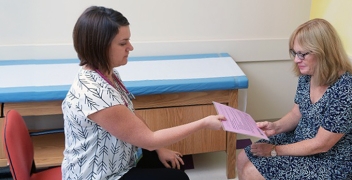Domestic Violence and Child Abuse
If we’re not assessing the risk of Intimate Partner Violence (IPV) for our pediatric patients, then we’re keeping our eyes closed to a strong and potent risk factor for child maltreatment.
Although IPV has obvious negative effects on the parents/caregivers involved, there are also serious consequences for children exposed to IPV in their homes. These can include physical outcomes such as poor physical health and substance use, as well as adverse mental health outcomes like anxiety, depression, and post-traumatic stress symptoms. Children may act out and be aggressive, and their parents may not connect the behavior to the IPV exposure in the home. The family unit itself can become isolated from other family members or friends in an attempt to hide the violence in the home.
There is also a proven link between domestic violence and child abuse. IPV, a form of domestic violence, is a widespread epidemic impacting children and families. It is estimated that over 15.5 million children in the U.S. are exposed annually to adult IPV at home, with young children making up the majority of exposed youth among families who seek police involvement for IPV. There is evidence to suggest that factors such as parental violence history, socioeconomic status, substance use, and neighborhood characteristics are significant predictors of IPV in homes with children.
The prevalence and serious negative outcomes associated with IPV makes it a serious public health concern. Fortunately, there are steps that a health care system can take to help break the cycle of violence within families.
CHOP’s STOP IPV program includes screening for IPV and offering universal education during clinical visits, training for hospital staff, and access to a full-time IPV counselor and other resources for families.
These policies have the potential to effectively identify children at potential risk, and reduce or eliminate children’s exposure to violence in the home through the provision of services to adult caregivers. The counselor can provide ongoing counseling support to any caregiver who identifies as a victim of violence. In addition, the counselor provides a one-time intervention that may include safety planning, shelter referrals, empowerment counseling, a danger assessment and other resources, as well as access to mental and behavioral health services for exposed children.
Facts and Stats
- Types of Intimate Partner Violence
There are five main types of IPV:
- Physical violence is the intentional use of physical force with the potential for causing death, disability, injury, or harm. Examples can include grabbing, choking, shoving, slapping, hitting, biting, kicking, punching, stabbing, shooting, or restraining from leaving.
- Sexual violence is divided into three categories:
- Use of physical force to compel or coerce a person to engage in a sexual act against his or her will.
- Attempted or completed sex act involving a person who is unable to understand the nature or condition of the act, to decline participation, or to communicate unwillingness to engage in the sexual act.
- Abusive sexual contact. Examples can include rape, treating a person in a sexually derogatory manner, accusations of infidelity, withholding sex, control over condom and contraception use, and forced termination of pregnancy or premature birth of a baby.
- Threats of physical or sexual violence where an individual uses words, gestures, or weapons to communicate the threat to cause death, disability, injury, or physical harm.
- Psychological/emotional violence involves trauma to the victim caused by acts, threats of acts, or coercive tactics. These may include humiliating or controlling the victim, deliberately making the victim feel diminished or embarrassed, isolating the victim from friends and family, threatening self-harm or suicide, and stalking.
- Economic violence is an attempt to make the victim financially dependent on the abuser. Examples can include maintaining total control over financial resources including victim's earned income or resources received through public assistance or social security, withholding money and/or access to money, and forbidding attendance at school or employment.
- Child Maltreatment
Child maltreatment (both abuse and neglect) is often linked with IPV, and encompasses any act or failure to act on the part of a parent or caregiver which results in harm to the child, including serious physical or emotional harm, sexual abuse or exploitation, or death.
Over 546,100 children were identified as victims of child abuse and neglect in 2023, based upon the U.S. Department of Health and Human Services statistics. This does not take into account children who were victimized more than once in the same year. Similar to the risk of IPV exposure, the youngest children are the most vulnerable to maltreatment. In 2023, 27.1% of all reported child abuse victims were younger than 2 years old. The vast majority (89%) of all child maltreatment victims were maltreated by a parent either acting alone or with someone else.
- The Consequences of Family Violence
Domestic violence and child abuse are truly “family violence” exposures that create and maintain a vicious cycle — exposed children are more likely to become involved in IPV throughout adolescence and adulthood as both victims and perpetrators.
Research shows that boys who witness domestic violence are twice as likely to abuse their own partners and children when they become adults. There is also an established link between child abuse and crime in later life; children who have experienced abuse are nine times more likely to become involved in criminal activities. Abused children have a higher risk of exhibiting violent behaviors. Research has shown that child abuse victims were more likely to perpetrate youth violence (up to 6.6% for females and 11.9% for males) and young adult IPV (up to 10.4% for females and 17.2% for males).
Family violence, whether physical, sexual, emotional, or verbal, is one of the most direct and potentially harmful forms of violence exposure that children experience due to its unique nature. It is usually not a sudden, isolated incident, but rather may involve years of emotional, psychological, and physical trauma that can escalate over time. A child can be an indirect victim of IPV as a witness and still face the serious consequences of the abuse.
- Domestic Violence and Child Abuse Statistics
65% of adults that abuse their partner also physically and/or sexually abuse their children.
- The majority of nonfatal intimate partner victimizations of women (two-thirds) in the United States occur at home.
- Self-reports by mothers who had experienced IPV also found that 44% of their children had been exposed to their IPV victimization.
- Research suggests that in an estimated 30 to 60% of the families where domestic violence is identified, some form of co-occurring child maltreatment is also present.
- In 2023, a nationally estimated 2,000 children died from abuse and neglect in the United States with the highest mortality in infants ( < 1 year of age).
- Approximately 67% of children that die from abuse are under the age of 3.
- Children exposed to maternal IPV, without experiencing child maltreatment, were 40% more likely to have behavioral problems than children not exposed to IPV.
- Nearly two-thirds of victims of child maltreatment receive child welfare services
Click here to read more perspectives on Intimate Partner Violence on the Research in Action blog.
- Related CVP Program










